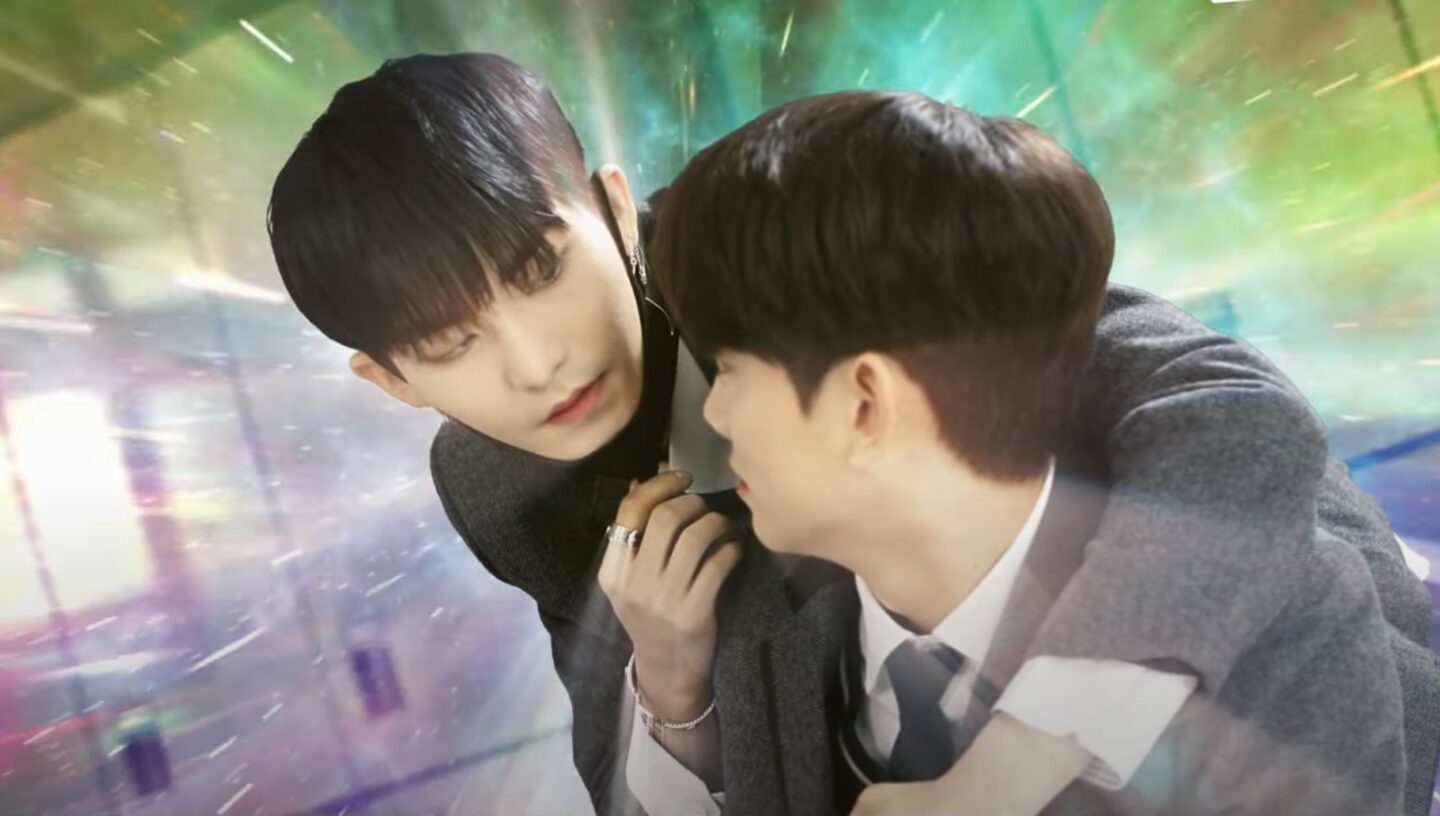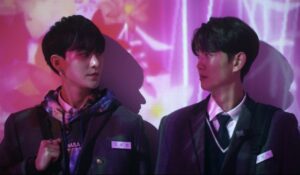
What if your first love didn’t just make your heart skip a beat, but quite literally filled your gray world with colors? That is the intriguing and visually arresting idea at the heart of Color Rush. This 8-episode web drama also happens to be the latest in South Korea’s recent flurry of BL (Boys’ Love) content.
South Korea is a little late to a party that has yielded hit shows and movies from countries like Taiwan, Thailand, Japan, and China. It is worth noting that while the situations facing LGBTQ+ people in most Asian nations (and really, most nations period) are complex and often challenging, especially compared to Taiwan and Japan, South Korea is a notably less queer-friendly place. This may have contributed to their reluctance to embrace official BL content, even as K-pop has become notorious for shipping and queer-baiting.
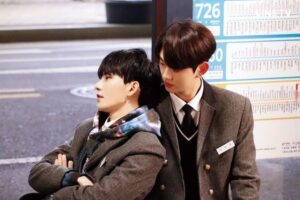
Now that they have jumped aboard the BL train though, the South Korean media industry brings a formidable level of production quality to the table. This has quickly shot their BL endeavors to high levels of prominence.
Color Rush is a promising example of what is possible at the intersection of strong South Korean television-making and BL content. Despite its unreasonably short run-time, the show leaves a strong impression due to its creativity and surprising moments of emotional resonance.
On the other hand, Color Rush suffers from troubles that will be all too familiar to frequent BL viewers. Problematic plot points abound, and the drama frequently exhibits an alarming lack of sensitivity. Color Rush has much to recommend it, but ultimately, it feels like yet another example of the enormous difficulties of making healthy queer content in a society that largely fails to meaningfully acknowledge, support, or celebrate its queer citizens.
Light gray, mouse gray, gray-white, dark gray, slate gray, taupe gray, cement gray, and true gray: this is the limited color palette that defines the world Choi Yeon-woo (Yoo Jun) inhabits. Yeon-woo is a “mono”, someone unable to see colors beyond a grayscale. Every mono has a “probe”, a person who can unlock the world of color for their mono as long as they are by their side. Yeon-woo meets his probe on his first day at a new school, the quirky Go Yoo-han (former The Boyz member Hur Hyun Jun). Cue boatloads of youthful angst, awkward teenage flirting, and intense face gazing.
As absurd as Color Rush’s premise may be, it is very effective. It allows the show to set itself apart through unique visuals. The way the drama portrays how color flows in and out of Yeon-woo’s life is arresting if occasionally lacking sophistication.
The drama is also fortunate with its lead actors. Yoo Jun and Hur Hyun Jun have unforced and pleasant chemistry, and both carry off the show’s frequently sappy material with impressive believability. Yoo Jun deserves special praise for executing a truly staggering amount of voice over work with convincing emotion. Color Rush is guilty of overusing this Yeon-woo perspective narration to move its plot along. However, with only eight 15-20 minute episodes to tell an entire story, the drama can be forgiven for taking a few shortcuts.
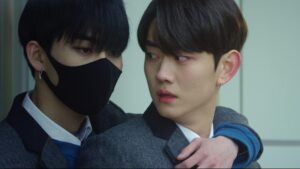
What is less permissible are the tone-deaf plot twists that dominate Color Rush’s second half. From the beginning, the drama features abrupt shifts in mood. Some scenes are pure light-hearted rom-com material, while others would belong best in a tense thriller. This is because while Yeon-woo and Yoo-han are falling for each other, Yeon-woo is also dealing with mono-related challenges, most alarmingly a dark history of monos kidnapping and even killing their probes in the hope of achieving permanent access to colors.
Yeon-woo’s fight against his worst instincts stays largely in the background throughout Color Rush’s opening episodes. However, this storyline comes roaring to the fore in episode 6. Tormented by greed and guilt, Yeon-woo seems to be on the verge of giving in to his demons, going to a hardware store to buy actual supplies to actually kidnap Yoo-han. Forgive the repetition of the word actual, but Color Rush’s choice to turn away from a cute yet thoughtful romance, and towards a dysfunctional and borderline criminal vibe, actually happens, and it actually sucks.
The following three paragraphs describe a scene that depicts a suicide attempt. There is also discussion of mental health challenges and suicide risk among queer youth. Readers who find such details distressing should proceed with caution.
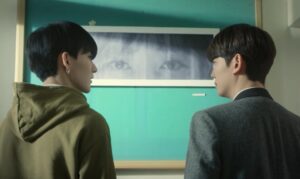
The drama pivots again in episode 7 when Yeon-woo decides that the only way to protect Yoo-han is to remove himself from the equation. In a painful-to-watch scene, Yeon-woo attempts to hang himself. Besides being disturbing, the sequence introduces the question of whether Yeon-woo’s hardware store trip was always aimed at self-harm rather than kidnapping, a question that is never resolved during Color Rush’s run. While neither answer is a good one, it does feel important to establish whether or not Yeon-woo truly intended to cause harm to Yoo-han, given the romantic ending Color Rush gives them. Living happily ever after with your would-be-kidnapper is not something that should be on the menu.
Though Yeon-woo’s suicide attempt is difficult to witness, the sequence itself is portrayed with a certain level of emotional awareness. Yeon-woo’s despair is rendered with respectful empathy. If Color Rush had used the scene as a catalyst to say something genuine about mental health, it could have been worth it. Unfortunately, the drama just blows past Yeon-woo’s suicide attempt. He tries to kill himself, and then Yoo-han comes and breaks him out of a mental facility. They go on a romantic trip to the seaside where, in an eleventh-hour deus ex machina, Yoo-han reveals that he suffers from facial blindness. Just as he has brought color into Yeon-woo’s life, Yeon-woo has brought faces into his. Just as Yeon-woo is obsessed with him, he is obsessed with Yeon-woo. Yay?

This entire plotline is unbelievably problematic, both minimizing mental health issues, and glorifying obsession as a form of love. It is especially offensive since Color Rush is a BL drama. While people of all identities struggle with mental health challenges, this is particularly true of queer folks, and even more true for queer youth. It is hard to find global data on this topic because of the lack of visibility of queer people in many nations, but for example, the U.S-based Trevor Project found that 40% of young LGBTQ+ youth that they surveyed had considered suicide in the last year.
Is it fair to hold Color Rush to a higher standard just because of its genre? The show shouldn’t be punished for being BL, right? Not exactly. For one thing, Color Rush’s narrative choices would be condemnable even if its lead couple were heterosexual. But also, Color Rush is BL, and it profits from being so. BL content increases queer representation, which is great. But even at its best, the genre relies on fetishizing queerness, something that is not true of many non-BL depictions of LGBTQ+ relationships. Therefore, the least a show like Color Rush can do is to try to be respectful of the queer community it is, to put it bluntly, taking advantage of.
Responsibility doesn’t have to mean relentlessly heavy content. Some of the least dysfunctional BL dramas completely avoid tough topics like mental health or discrimination, instead painting a rosy picture of unconstricted queer romance. You can criticize these dramas as unrealistic, but they serve a positive purpose by counteracting stereotypes of LGBTQ+ love stories as inevitably doomed. However, if a BL show does decide to include challenging content, it needs to take it seriously. Otherwise, it can end up in an exploitative and distasteful place, which is exactly what happens to Color Rush.
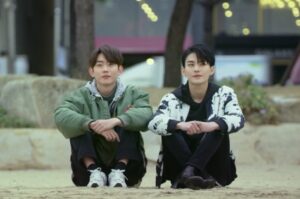
The real shame of it is that the drama comes tantalizingly close to being something really worthwhile. As fantastical as the mono and probe concept is, it actually works as an excellent metaphor for the experience of being a young queer person falling in love. As a mono, Yeon-woo is subtly isolated and discriminated against. He is told that his attraction towards his probe Yoo-han is wrong, even as Yoo-han brightens his life with literal technicolor. He struggles with feelings of fear and shame as his affection for Yoo-han deepens. He ultimately chooses to cast aside all naysayers, to trust and follow his heart.
If Color Rush had brought its intriguing story to life in a thoughtful way, it could have been a real BL gem. Unfortunately, that did not happen. Is Color Rush’s combination of high potential, strong production, and disastrous narrative execution indicative of the future of South Korean BL offerings? Only time will tell. Based on South Korea’s current mainstream attitudes towards the LGBTQ+ community, and its drama industry’s longtime love affair with toxic romance, color this viewer pessimistic. That being said, I very much look forward to being proven wrong.
(BBC, CNN, New York Times, NPR, Trevor Project, YouTube. Images via Conversion TV, Story Wiz, Viki)
